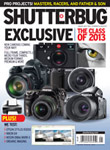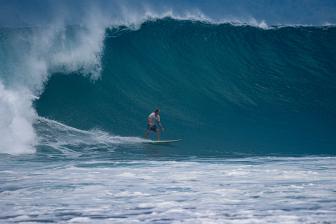Newsletter
Sort By: Post Date TitlePublish Date
|
Dec 11, 2012 |
First Published: Jan 01, 2013
|
Dec 11, 2012
|
Dec 11, 2012
|
Nov 18, 2012 |
First Published: Dec 01, 2012
|
Nov 17, 2012
|
Nov 17, 2012
|
Nov 17, 2012
|
Oct 18, 2012 |
First Published: Nov 01, 2012
|
Sep 14, 2012 |
First Published: Oct 01, 2012
 On The Cover
On The Cover


 On The Cover
On The Cover Portrait lighting sources have 4 major characteristics: color, direction, quantity and quality. When working with any light source, from speedlights to moonlights, the best way to improve the quality of your lighting is with modification devices such as an umbrella or a lightbank. Each one has their own advantages and disadvantages. But no matter which one you chose, each device is governed by this important rule. The closer a light source is to the subject the softer it is; the further away the light source is, the harder it becomes.
Portrait lighting sources have 4 major characteristics: color, direction, quantity and quality. When working with any light source, from speedlights to moonlights, the best way to improve the quality of your lighting is with modification devices such as an umbrella or a lightbank. Each one has their own advantages and disadvantages. But no matter which one you chose, each device is governed by this important rule. The closer a light source is to the subject the softer it is; the further away the light source is, the harder it becomes.  Rain or shine, you can always depend on an umbrella to give you soft, even illumination on your subjects. Whether using tungsten lighting, photofloods, or flash activated monolights, pointing the light into the umbrella will provide a controllable source of lighting. What follows are just some of the possibilities you have at your disposal with umbrellas. Changing the positioning of the unit(s), the output, the color of the umbrella, adding a gel and changing the background can make any subject a work of art.
Rain or shine, you can always depend on an umbrella to give you soft, even illumination on your subjects. Whether using tungsten lighting, photofloods, or flash activated monolights, pointing the light into the umbrella will provide a controllable source of lighting. What follows are just some of the possibilities you have at your disposal with umbrellas. Changing the positioning of the unit(s), the output, the color of the umbrella, adding a gel and changing the background can make any subject a work of art.
 All the elements were right for Robert Beck to try something different. Shooting for Sports Illustrated at the 2010 Winter Olympics in Vancouver, Robert’s coverage included both the qualifying and medal rounds of the men’s aerials event in freestyle skiing, so there was plenty of opportunity for him to capture not only the razor-sharp peak-action images that typify SI coverage, but also to modify his technique to take a shot or two at turning prose into poetry.
All the elements were right for Robert Beck to try something different. Shooting for Sports Illustrated at the 2010 Winter Olympics in Vancouver, Robert’s coverage included both the qualifying and medal rounds of the men’s aerials event in freestyle skiing, so there was plenty of opportunity for him to capture not only the razor-sharp peak-action images that typify SI coverage, but also to modify his technique to take a shot or two at turning prose into poetry.
 On The Cover
On The Cover
 On The Cover
On The Cover
